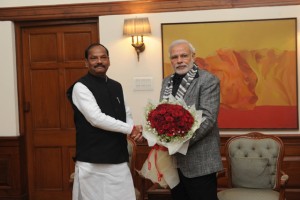The Chief Minister of India’s Jharkhand state celebrated the 91st birthday of a prominent leader of his political party, the BJP, by calling attention to the needs of the Birhor people.

On December 25, Chief Minister Raghubar Das went to the Birhor village of Dohakatu, in the Ramgarh district of Jharkhand, to celebrate the birthday of Atal Bihari Vajpayee, a former BJP Prime Minister of India. Das said to the assembled tribal people and reporters that Vajpayee’s work on behalf of India’s tribal societies was praiseworthy.
Das said that the former prime minister had been an exemplary politician during his 60 years of political life. The Chief Minister used the occasion of Vajpayee’s birthday celebration to announce that he was planning to establish a separate section in the forthcoming annual budget for the so-called “primitive tribes” of his state. As he accepted a piece of birthday cake from a Birhor student, he commented that his administration has taken initiatives to try and improve the conditions of the tribal society.
One of the news sources covering the event indicated that Das helped some Birhor children cut a three-layer birthday cake, and during the hour he was in the village he distributed fruits and blankets to the 17 families living there. Other state officials—Chandra Prakash Choudhary, Minister for Water Resources, and Ramkumar Pahan, a member of the legislative assembly, accompanied the Chief Minister to the Birhor village.
The birthday celebration was obviously a political event, and it was not clear from any of the news reports how the Birhor themselves reacted. Doubtless they appreciated the blankets and gifts of food. One has to wonder if they organized one of their own traditional celebrations after the luminaries left.
Kujur and Topno (1999) provide a detailed description of Birhor celebrations and dances, an important way, they write, for the people to cement the bonds of their community lives. They argue that festivities help the Birhor maintain the integrity of their society. Their dances help them relax when the work of the day is over, but the celebrating also “very concretely express[es] their philosophy of life, that life is a celebration for them,” despite all the suffering and struggles that they have to put up with every day (p.44–45).
The authors describe the synchronization of music, song and dance that characterize all Birhor celebrations, which are inseparable parts of their lives. Kujur and Topno point out that everyone dances the night away on festive occasions. They describe, in their essay, the different elements of the celebrations: movements, places of dancing, musical instruments, and so on.
A YouTube video shows a celebration taking place in a Birhor village, with three and then four people dancing and singing, surrounded by their fellow villagers. At the end of over five minutes of singing and dancing, the camera pans around the village to show the houses surrounding a large central square plus numerous villagers gathered to observe the singing and dancing.
It is unfortunate that the press so often focuses on the ways politicians celebrate one another rather than on the ways real people celebrate life and peace.